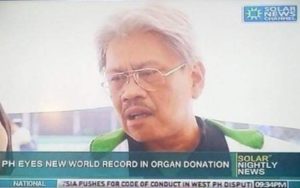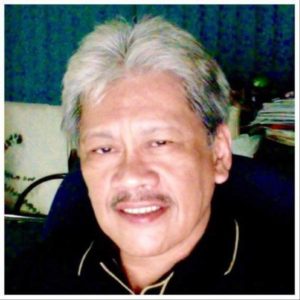Kidney Transplantation with PSN: Giving Life a Second Chance
Maria Eliza R. Navarro, MD, FPCP, FPSN

When the PSN came to be, the Philippines was not far behind the rest of the world when it came to renal transplantation. It was evident that the return of many foreign-trained subspecialists had paved the way for promising developments and opportunities in the treatment of kidney diseases in the country.

On December 26, 1968, the first kidney transplant was done by Dr. Enrique Esquivel at the University of the Philippines-Philippine General Hospital (UP-PGH). The first successful kidney homotransplantation, or living related kidney donor kidney transplant, was done at University of Santo Tomas (UST) Hospital in November 1969. Dr. Domingo Antonio, head of the Department of Surgery at UST, was assisted by a team that included Dr. Enrique Ona and nephrologists Dr. Romeo Abella (MD 1959, UST), Dr. Aurora Padolina-Perez (MD 1954, UST) and Dr. Robert Soriano (MD 1963, UST).
Amid the tense sociopolitical environs at the start of the 1980s, the field of nephrology received a welcome boost. The National Kidney Foundation of the Philippines (NKFP) was created in January 16, 1981 by virtue of Section I of Presidential Decree 1832, with the purpose of establishing a hospital specializing in kidney diseases and transplantation, as part of a network of facilities that included the Philippine Heart Center and the Lung Center of the Philippines. The cornerstone of the NKFP building was laid on February 23, 1983 and on the same day, the first kidney transplant at NKFP was performed by a team led by Dr. G. Baird Helfirch of Georgetown University in Washington D.C., USA.
The NKFP was groundbreaking at that time and was constructed in a unique hospital configuration geared for transplant operations. Utilization of a laminar flow air conditioning system with high efficiency particulate air (HEPA) filter and state of the art laboratory equipment stood at par with international standards. Under the leadership of Dr. Claver Ramos as its first director, the NKFP embarked on an ambitious kidney transplant program that endeavored to make kidney transplantation a viable treatment option for the Filipino patient.
Together with the advances in infrastructure came the boon of using anti-rejection medications that was not even available in the US market at that time. Thru Sandoz Philippines (now Novartis Healthcare), the Philippines became one of the first countries in the world to approve the use of Cyclosporine A, a revolutionary anti-rejection drug in organ transplantation.
On August 5, 1983, the first living related kidney transplant was performed at NKFP. Yet the necessity for organs from deceased donors was recognized so a directive to launch an organ retrieval program was issued. Under the direction of Dr. Claver Ramos, Assistant Director Dr. Potenciano Baccay and transplant surgeon Dr. Enrique Ona, the Cadaver Organ Retrieval Effort (CORE) was formed in December 1983 with Dr. Antonio Paraiso at its helm. This program was later renamed to what we know now as the Human Organ Preservation Effort (HOPE). On November 12, 1986, the NKFP was renamed the National Kidney Institute, with Dr. Filoteo Alano succeeding Dr. Ramos as director in 1986. The NKI was just one of several institutions now actively advocating continuing medical education thru its Fellowship Training in Nephrology, and so the ranks of PSN grew and thrived.
There have been shifts and periods of change in the field of kidney transplantation, and with it came challenges and controversies. Reverting to its mission of sponsoring the health of kidney patients, the society worked with the national government and its international partners to ensure the equity and beneficence in the discipline of kidney transplantation. This occasioned the release of key government mandates:
- Administrative Order No. 2008-0034 – Revised Rules and Regulation Governing Accreditation of Hospitals Engaged in Kidney Transplantation
- Administrative Order No. 81 s., 2003 – Rules and Regulations Governing Accreditation of Hospital Engaged in the Conduct of Kidney Transplantation
The COVID-19 pandemic presented new and unprecedented difficulties in the practice of kidney transplantation. The KT reduction rate relative to 2019 stood at 37% nationwide and this also effected challenges in the training of young nephrologists. As of present, the training institutions have been gradually adapting to this situation, with the PSN leading the way and setting direction in this unique period in our history.
Trends in immunosuppression, access to the latest technology and clinical expertise have made the management of both standard and high-risk transplant patients possible more than ever. Use of induction therapy with rATG and basiliximab has made transplantation even of tissue typing mismatches viable. The use of cyclosporine is slowly being supplanted with tacrolimus. Desensitization with rituximab + plasmapheresis for highly sensitized patients is giving hope to recipients who would have remained high risk for graft rejection. Local data corroborate that our results are comparable with global outcomes in patient and graft survival. Yet the greatest obstacle remains- the scarcity of donors to match the number of patients who need a kidney transplant and making this treatment option less prohibitive for the majority. The number of recipients continues to outpace the number of donors, whether living or deceased.
There are still challenges and issues in sundry. Nonetheless, the PSN will stay the course. As it has always done some 50 years ago when it all began.
(Acknowledgements/Sources: Dr. Concesa Casasola, Beyond Measure: 40 years of the PSN)







